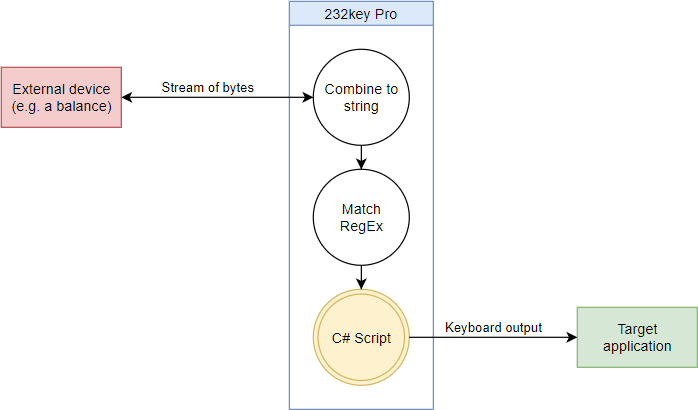232key Pro data flow

232key Pro works with data strings or “lines of data”. A line is created every time the Terminator character is found in the stream of bytes received from your device (or when no additional bytes have been received for the duration of the Timeout, if set).
Next, 232key Pro attempts to match a regular expression (regex) in each line. The results of this match are made available to your C# script in the variables described below.
Your script runs every time a match is found. It can transform this data in any way you want using the C# language. At he end of your script, return a string that 232key should type, e.g:
return value+'\n';This is the default script in 232keyPro. It simply takes the value variable (see below) and adds a new line character (which will be transformed into the ENTER key).
Note: The Encoding set under Settings > General Settings is used when the bytes received from your device are first converted to a string.
Variables with captured data
- String value: The string matched by the first capturing group of the regex (or an empty string if nothing was captured). This string is highlighted in blue in the Event Log. Most tasks can be solved by using the value string.
- Example with four lines of data sent from a scale when the “Generic measuring instrument” device profile has been selected in the Input tab:
 The regex associated with this device profile captures the first number it encounters in each line (in this case, the weight, e.g. 8.738). Your script would run once for every line and the value variable would contain the following values:
The regex associated with this device profile captures the first number it encounters in each line (in this case, the weight, e.g. 8.738). Your script would run once for every line and the value variable would contain the following values: - 8.738
- 8.736
- 8.736
- 8.738
Tip: You can use the C# String.Trim method to trim extra white spaces captured by the regex. Example:
return value.Trim()+'\n';For further formatting, please see NumberFormatter.Format below.
- Double? valueDouble: The value string described above converted to a Double or null if the conversion was not successful.
- Decimal? valueDecimal: The value string converted to a Decimal or null if the conversion was not successful.
- Match firstMatch: The first match of the regex (or null if no match was found). Useful to access multiple capturing groups defined in a custom regular expression: firstMatch.Groups[1].Value corresponds to value (but can be null), firstMatch.Groups[2].Value is the string matched by the second capturing group, etc.
- MatchCollection allMatches: All matches of the regular expression (or null if no matches were found). Use this when the regex matches more than once (and you want to access all matches).
Tip: If you’d rather parse all data in your script instead of dealing with regular expressions, you can set the Device in the Input tab to “Generic text device“. This will use a regex which matches all characters except for line feed and carriage return. If you want those as well, change the regex to “([\s\S]+)” (without the quotation marks). All data sent from the connected device will then be available in the value string.
Using the ([\s\S]+) regex, the same input as in the example above would look like this in the Event Log, showing that all data sent by the scale has been matched:
![]()
Functions
Other than using regular C# code, you can call the following functions from your script to simplify common tasks.
NumberFormatter.Format – formats a string as a number
string Format(string capturedString, bool useComma, NumberStyles numberStyles)
This function trims white spaces and removes leading zeros. The decimal separator can be set to a dot or comma.
Parameters
- capturedString String: The string to format as a number (usually the value variable).
- useComma bool: If true, use a comma as the decimal separator. If false, use a decimal point.
- numberStyles enum System.Globalization.NumberStyles: Style to use for formatting (you’ll usually want to use NumberStyles.Number)
Returns
String: Formatted string or original string if number conversion fails.
Script example
return NumberFormatter.Format(value, true, NumberStyles.Number);Formats captured data as number with a comma as the decimal separator and returns it to 232key Pro for output.
Constants
For your convenience, the following constants are available to your script:
- ESC: The escape character (‘\u001b’). Meant to be used with escape sequences (see examples below).
User variables
You can define any variable you want in your script*, but the variable will be re-initialized every time the script runs, which is every time a line of data is processed. There’s currently no way to avoid if we also want to use extremely fast compiled scripts.
To maintain state between script executions, the following arrays with 10 elements are available:
- bool[10] Bools
- int[10] Ints
- double[10] Doubles
- string[10] Strings
- decimal[10] Decimals
The variables are maintained even when the script is stopped and restarted. However, they are lost when the program is closed.
*Note: You cannot use reserved keywords or the following names for your own (temporary) variables: allMatches, Bools, Decimals, Doubles, ESC, firstMatch, Ints, match (alias for value), Strings, value.
Script example
Ints[0]++; //Increase by one
return $"{Ints[0]}: {value}\n";Note: The dollar sign ($) is not typed, it means that the string literal following it may contain {interpolated expressions}. Instead, you could also write:
return Ints[0]+": " +value+'\n';Example output from a weighing scale:
1: 8.234 2: 2.686 3: 26.740
Tip: Wondering where the blank spaces in the output are coming from? Except for the one we’ve explicitly added, they were already present in the value variable as the regex defined for this device had captured them.
Adding the date and time
You can easily add the current date and time using DateTime.Now.ToString(). A comprehensive list of format specifiers can be found here.
Note: 232key Pro uses the invariant culture.
Script example
return $"{DateTime.Now.ToString("yyyy-mm-dd")}\t"
+$"{DateTime.Now.ToString("HH:mm:ss")}\t{value}";Types the current date (+TAB) and the current time (+TAB) ahead of the content of the value variable and then presses the ENTER key.
Note: The string is broken up into two lines for readability. You could also write the expression in one line:
return $"{DateTime.Now.ToString("yyyy-mm-dd")}\t{DateTime.Now.ToString("HH:mm:ss")}\t{value}";Example output from a weighing scale
022-26-07 13:26:35 123.45 Adding characters
There are currently two ways to add characters which 232key Pro will then convert to keyboard events.
Using the default output settings
A keyboard event is created for each character in the string returned from your script. The Unicode flag is set for all characters with the exception of tab (\t) and line feed (\n, translated to the ENTER key), which means that you don’t have to worry about keyboard layouts and modifiers.
Script example
return $"中間值: {value}\n";Types “中間值: ” (average) in front of the content of the value variable and then presses the ENTER key.
Example output from a weighing scale
中間值: 8.738Using GIDEI
To type non-alphanumeric keys and key combinations, set the Output Method in the Settings tab to GIDEI and use one of the GIDEI escape sequences described below.
The keys listed below are currently supported.
Note: Outside of GIDEI escape sequences, all characters are supported just like in the default output mode! We recommend using GIDEI aliases only for non-printable keys and key combinations.
Detailed information on GIDEI (also implemented as Windows SerialKeys up to XP) can be found in this document.
GIDEI support in 232key is currently incomplete and has to be considered experimental.
Individual keys
Start the escape sequence with the ESC character (ASCII 27), followed by one key name and a period (ASCII 46). White spaces are optional:
ESC Keyname .
GIDEI script example with multiple individual keys
return $"{ESC}delete.{value}{ESC}tab.{ESC}tab.{ESC}enter.";Presses the DEL key ahead of the content of the value variable, then TAB twice and finally ENTER. Each GIDEI escape sequence is shown in a different color.
Key combinations
232key currently supports the combine command to create key combinations.
A key combination consists of the escape character (ASCII 27), the combine command and the key names, separated by commas. It ends with a period (ASCII 46):
ESC , combine [ , Keyname1 ] [ , Keyname2 ] [, Keyname3 ] [ , etc] .
GIDEI script example with key combinations
return $"{ESC}, combine, control, f.{value}";Presses Ctrl + F and then types the content of the value variable.
Currently supported GIDEI key names
| GIDEI Key Name | Description |
|---|---|
| 0…9 | Keys 0 to 9 |
| A…Z | Keys A to Z |
| alt | ALT key |
| altgr | Right ALT key |
| backspace bspace | BACKSPACE key |
| capslock | CAPS LOCK key |
| control ctrl | Left CONTROL key |
| enter | ENTER key |
| f1…f24 | F1…F24 function keys |
| del delete | DEL key |
| divide | Numpad DIVIDE key (/) |
| down | DOWN ARROW key |
| end | END key |
| escape | ESC key |
| home | HOME key |
| ins insert | INSERT key |
| kp* kpstar | Numpad MULTIPLY key (*) |
| kp+ kpplus | Numpad ADD key (+) |
| kp- kpminus | Numpad SUBTRACT key (-) |
| kp/ kpdivide kpslash | Numpad DIVIDE key (/) |
| kp0…kp9 | Numpad 0 to 9 keys |
| kpdp | Numpad DECIMAL POINT key |
| lcontrol lctrl | Left CONTROL key (same as control) |
| left | LEFT ARROW key |
| lshift | Left SHIFT key |
| menu | ALT key (same as alt) |
| next | PAGE DOWN key |
| numlock | Numpad NUM LOCK key |
| prior | PAGE UP key |
| rcontrol rctrl | Right CONTROL key |
| return | ENTER key (same as enter) |
| right | RIGHT ARROW key |
| rshift | Right SHIFT key |
| tab | TAB key |
| up | UP ARROW key |
